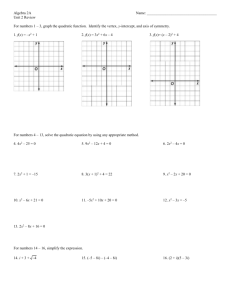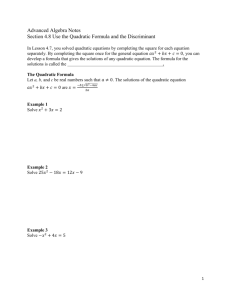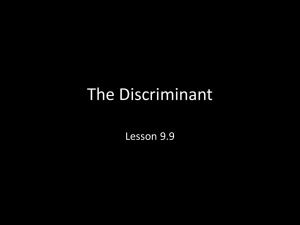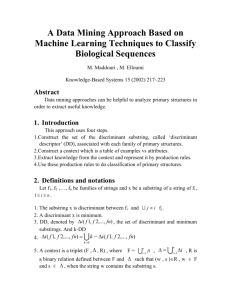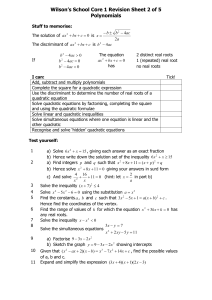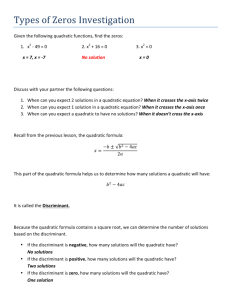9.7 Using the Discriminant
advertisement
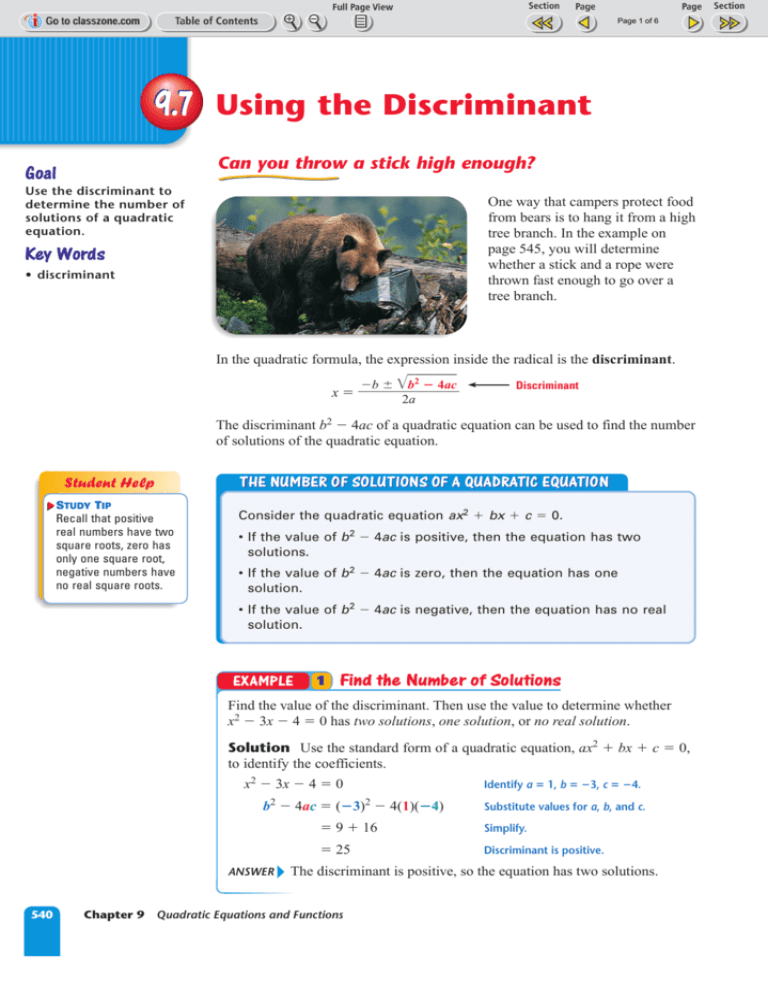
Page 1 of 6 9.7 Using the Discriminant Can you throw a stick high enough? Goal Use the discriminant to determine the number of solutions of a quadratic equation. One way that campers protect food from bears is to hang it from a high tree branch. In the example on page 545, you will determine whether a stick and a rope were thrown fast enough to go over a tree branch. Key Words • discriminant In the quadratic formula, the expression inside the radical is the discriminant. b b2 4ac x 2a Discriminant The discriminant b2 4ac of a quadratic equation can be used to find the number of solutions of the quadratic equation. Student Help THE NUMBER OF SOLUTIONS OF A QUADRATIC EQUATION STUDY TIP Recall that positive real numbers have two square roots, zero has only one square root, negative numbers have no real square roots. Consider the quadratic equation ax2 bx c 0. • If the value of b 2 4ac is positive, then the equation has two solutions. • If the value of b 2 4ac is zero, then the equation has one solution. • If the value of b 2 4ac is negative, then the equation has no real solution. EXAMPLE 1 Find the Number of Solutions Find the value of the discriminant. Then use the value to determine whether x2 3x 4 0 has two solutions, one solution, or no real solution. Solution Use the standard form of a quadratic equation, ax2 bx c 0, to identify the coefficients. x2 3x 4 0 b2 4ac (3)2 4(1)(4) ANSWER 540 Chapter 9 Identify a 1, b 3, c 4. Substitute values for a, b, and c. 9 16 Simplify. 25 Discriminant is positive. The discriminant is positive, so the equation has two solutions. Quadratic Equations and Functions Page 2 of 6 EXAMPLE 2 Find the Number of Solutions Find the value of the discriminant. Then use the value to determine whether the equation has two solutions, one solution, or no real solution. a. x2 2x 1 0 b. 2x2 2x 3 0 Solution a. x2 2x 1 0 Identify a 1, b 2, c 1. b 4ac (2) 4(1)(1) 2 ANSWER 2 Substitute values for a, b, and c. 44 Simplify. 0 Discriminant is zero. The discriminant is zero, so the equation has one solution. b. 2x 2x 3 0 2 Identify a 2, b 2, c 3. b2 4ac (2)2 4(2)(3) ANSWER Substitute values for a, b, and c. 4 24 Simplify. 20 Discriminant is negative. The discriminant is negative, so the equation has no real solution. Find the Number of Solutions Find the value of the discriminant. Then use the value to determine whether the equation has two solutions, one solution, or no real solution. 1. x2 3x 4 0 2. x2 4x 4 0 3. x2 5x 4 0 Because each solution of ax2 bx c 0 represents an x-intercept of y ax2 bx c, you can use the discriminant to determine the number of times the graph of a quadratic function intersects the x-axis. EXAMPLE 3 Find the Number of x-Intercepts Determine whether the graph of y x2 2x 2 will intersect the x-axis in zero, one, or two points. Solution Let y 0. Then find the value of the discriminant of x2 2x 2 0. x2 2x 2 0 Identify a 1, b 2, c 2. b 4ac (2) 4(1)(2) 2 ANSWER 2 Substitute values for a, b, and c. 48 Simplify. 12 Discriminant is positive. The discriminant is positive, so the equation has two solutions and the graph will intersect the x-axis in two points. 9.7 Using the Discriminant 541 Page 3 of 6 EXAMPLE Student Help MORE EXAMPLES NE ER T INT More examples are available at www.mcdougallittell.com Find the Number of x-Intercepts 4 Determine whether the graph of the function will intersect the x-axis in zero, one, or two points. a. y x2 2x 1 b. y x2 2x 3 Solution a. Let y 0. Then find the value of the discriminant of x2 2x 1 0. x2 2x 1 0 Identify a 1, b 2, c 1. b2 4ac (2)2 4(1)(1) ANSWER Substitute values for a, b, and c. 44 Simplify. 0 Discriminant is zero. The discriminant is zero, so the equation has one solution and the graph will intersect the x-axis in one point. b. Let y 0. Then find the value of the discriminant of x2 2x 3 0. x2 2x 3 0 Identify a 1, b 2, c 3. b 4ac (2) 4(1)(3) 2 ANSWER EXAMPLE Student Help LOOK BACK For help with sketching the graph of a quadratic function, see p. 521. 2 Substitute values for a, b, and c. 4 12 Simplify. 8 Discriminant is negative. The discriminant is negative, so the equation has no real solution and the graph will intersect the x-axis in zero points. 5 Change the Value of c Sketch the graphs of the functions in Examples 3 and 4 to check the number of x-intercepts of y x2 2x c. What effect does changing the value of c have on the graph? Solution By changing the value of c, you can move the graph of y x2 2x c up or down in the coordinate plane. y 4 c a. y x2 2x 2 b. y x2 2x 1 b 4 c. y x2 2x 3 If the graph is moved high enough, it will not have an x-intercept and the equation x2 2x c 0 will have no real solution. 1 1 a Find the Number of x-Intercepts Find the number of x-intercepts of the graph of the function. 4. y x2 4x 3 542 Chapter 9 Quadratic Equations and Functions 5. y x2 4x 4 6. y x2 4x 5 2 x Page 4 of 6 9.7 Exercises Guided Practice Vocabulary Check 1. Write the quadratic formula and circle the part that is the discriminant. 2. What can the discriminant tell you about a quadratic equation? 3. Describe how the graphs of y 4x2, y 4x2 3, and y 4x2 6 are alike and how they are different. Skill Check Use the discriminant to determine whether the quadratic equation has two solutions, one solution, or no real solution. 4. 3x2 3x 5 0 5. 3x2 6x 3 0 6. x2 5x 10 0 Give the letter of the graph that matches the value of the discriminant. 7. b2 4ac 2 8. b2 4ac 0 9. b2 4ac 3 A. B. C. y y x y x x Determine whether the graph of the function will intersect the x-axis in zero, one, or two points. 10. y x2 2x 4 11. y x2 3x 5 12. y 6x 3 3x2 Practice and Applications WRITING THE DISCRIMINANT Find the discriminant of the quadratic equation. Student Help HOMEWORK HELP Example 1: Exs. 13–33 Example 2: Exs. 13–33 Example 3: Exs. 38–43 Example 4: Exs. 38–43 Example 5: Exs. 44–46 13. 2x2 5x 3 0 14. 3x2 6x 8 0 15. x2 10 0 16. 5x2 3x 12 17. 2x2 8x 8 18. 7 5x2 9x x 19. x 7x2 4 20. 2x x2 x 21. 2 x2 4x2 USING THE DISCRIMINANT Determine whether the equation has two solutions, one solution, or no real solution. 22. x2 3x 2 0 23. 2x2 4x 3 0 24. 3x2 5x 1 0 25. 2x2 3x 2 0 26. x2 2x 4 0 27. 6x2 2x 4 0 28. 3x2 6x 3 0 29. 4x2 5x 1 0 30. 5x2 6x 6 0 1 31. x2 x 3 0 2 1 32. x2 2x 4 0 4 4 33. 5x2 4x 0 5 9.7 Using the Discriminant 543 Page 5 of 6 34. ERROR ANALYSIS For the equation 3x2 4x 2 0, b2 – 4ac =(4)2 – 4(3)(–2) = 16 – 24 = –8 find and correct the error. INTERPRETING THE DISCRIMINANT In Exercises 35–37, consider the quadratic equation y 2x2 6x 3. 35. Evaluate the discriminant. 36. How many solutions does the equation have? 37. What does the discriminant tell you about the graph of y 2x2 6x 3? NUMBER OF X-INTERCEPTS Determine whether the graph of the function will intersect the x-axis in zero, one, or two points. 38. y 2x2 3x 2 39. y x2 2x 4 40. y 2x2 4x 2 41. y 2x2 2x 6 42. y 5x2 2x 3 43. y 3x2 6x 3 CHANGING THE VALUE OF C Match the function with its graph. 44. y x2 2x 1 A. 45. y x2 2x 3 B. y 2 y 2 4 x 4 6 Careers C. y 2 6 46. y x2 2x 3 2 2 2 6 x 6 2 2 x 6 FINANCIAL ANALYSIS In Exercises 47–49, use a graphing calculator and the following information. FINANCIAL ANALYSTS INT use mathematical models to help analyze and predict a company’s future earnings. NE ER T More about financial analysts is available at www.mcdougallittell.com 544 Chapter 9 Software Company Profits Profit (millions of dollars) A software company’s net profit for each year from 1993 to 1998 lead a financial analyst to model the company’s net profit by P 6.84t2 3.76t 9.29, where P is the profit in millions of dollars and t is the number of years since 1993. In 1993 the net profit was approximately 9.29 million dollars (t 0). P 400 200 0 0 2 4 6 8 Years since 1993 t 47. Give the domain and range of the function for 1993 through 1998. 48. Use the graph to predict whether the net profit will reach 650 million dollars. 49. Use a graphing calculator to estimate how many years it will take for the company’s net profit to reach 475 million dollars according to the model. Quadratic Equations and Functions Page 6 of 6 Using the Discriminant EXAMPLE Camping You and a friend want to get a rope over a tree branch that is 20 feet high. Your friend attaches a stick to the rope and throws the stick upward with an initial velocity of 29 feet per second. You then throw it with an initial velocity of 32 feet per second. Both throws have an initial height of 6 feet. Will the stick reach the branch each time it is thrown? CAMPING Solution Use a vertical motion model for an object that is thrown: h 16t2 vt s, where h is the height you want to reach, t is the time in motion, v is the initial velocity, and s is the initial height. h 16t2 vt s h 16t2 vt s 20 16t2 29t 6 20 16t2 32t 6 0 16t2 29t 14 CAMPING Bears have an excellent sense of smell that often leads them to campsites in search of food. Campers can hang a food sack from a high tree branch to keep it away from bears. 0 16t2 32t 14 b2 4ac (29)2 4(16)(14) b2 4ac (32)2 4(16)(14) The discriminant is 55. The discriminant is 128. ANSWER ANSWER The discriminant is negative. The stick thrown by your friend will not reach the branch. The discriminant is positive. The stick thrown by you will reach the branch. 50. BASKETBALL You can jump with an initial velocity of 12 feet per second. You need to jump 2.2 feet to dunk a basketball. Use the vertical motion model h 16t2 vt s to find if you can dunk the ball. Justify your answer. Standardized Test Practice 51. MULTIPLE CHOICE For which value of c will 3x2 6x c 0 not have a real solution? A c < 3 B c 3 C D c > 3 c3 52. MULTIPLE CHOICE How many real solutions does x2 10x 25 0 have? F Mixed Review No solutions G One solution H Two solutions J Many solutions SOLVING AND GRAPHING INEQUALITIES Solve the inequality. Then graph the solution. (Lesson 6.4) 53. 2 ≤ x 1 < 5 54. 8 > 2x > 4 55. 12 < 2x 6 < 4 GRAPHING LINEAR INEQUALITIES Graph the inequality. (Lesson 6.8) 56. 3x y ≤ 9 Maintaining Skills 58. 2x y ≥ 4 57. y 4x < 0 MULTIPLYING DECIMALS Find the product. (Skills Review p. 759) 59. 3 0.02 60. 0.7 0.8 61. 0.1 0.1 62. 0.05 0.003 63. 0.09 0.02 64. 0.06 0.0004 9.7 Using the Discriminant 545

